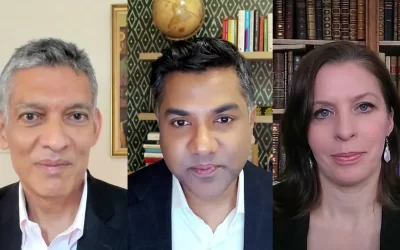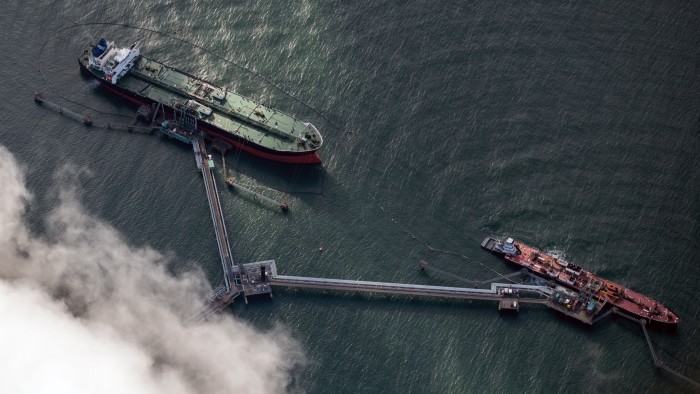‘The end of an era.’ What next for global trade?
The Trump administration had a bullish message after Wednesday’s wrenching volte-face on tariffs: the continuing turmoil will do nothing to dim the US’s lustre as the world’s most attractive trading power.
The entire world is calling Washington, said press secretary Karoline Leavitt, speaking to reporters in front of the West Wing. “They need our markets, they need our consumers, and they need this president in the Oval Office to talk to them.”
The mood in other capitals could hardly have been more different.
Ever since the November election, trade officials from Asia to Europe and South America have been seeking ways to diversify their economies away from a US that appears determined to shred the global trading order.
Those efforts have only accelerated since Donald Trump’s “liberation day” tariff package unveiled on April 2. Economic ministers from across south-east Asia met on Thursday afternoon for emergency talks, while the EU stepped up discussions this week with trading partners from the Middle East to the Asia-Pacific region.
Top trade officials and economists see a seismic shift under way. Much of the world is doubling down on globalisation while the US turns its back on the postwar trading system it played such a central part in forging.
“There will be more trade deals among the regions of the rest of the world as they seek to recover markets that they have been locked out from in the US,” says Maurice Obstfeld, former IMF chief economist who is now at the Peterson Institute for International Economics.
Declarations of independence from US trade will undoubtedly prove easier to voice than to put into practice given exporters’ ongoing reliance on America’s voracious consumer goods market.
And despite vows by leaders in Asia, Europe and the Middle East to seek more amenable partners than Trump, there is much that will continue to divide other parts of the world when it comes to trade policy.
The biggest flashpoint lying ahead is the potential for Trump’s vertiginous tariffs on China — escalated to 125 per cent as part of Wednesday’s announcements — to provoke a flood of cheap Chinese products pouring into other markets. On Friday, China raised its own tariff on US goods to 125 per cent.
Yet the attempts to forge new partnerships outside America’s orbit reflect a calculation among global leaders that Trump’s hostility to trade will drive an enduring period of uncertainty. Coming on the heels of the president’s moves to abandon decades-old agreements on defence, security, health and foreign aid, it heralds a permanent reorientation in global relationships with a US no longer seen as a reliable ally.
“This is the end of an era,” says Vivian Balakrishnan, Singapore’s foreign minister. “The recent developments have convinced us that we need to accelerate this process of making common cause for multilateralism, economic integration, free flow of trade and investments and technology with as wide a group as possible.”
Even before Trump’s “liberation day”, trade ministries around the world were stepping up diplomatic efforts to forge fresh links that might exclude the US.
In recent weeks, government officials from several south-east Asian nations have visited countries as far flung as New Zealand, France, Brazil and India to discuss strengthening trade ties. These talks are building on several longer term initiatives to sign free trade agreements that cover huge geographic areas.

Singapore has been driving two key regional initiatives in a bid to create a free-trade area that spans the Asia-Pacific region. Talks are also being planned between the leaders of the 10 nations in the Association of Southeast Asian Nations (Asean) and those from the Gulf Cooperation Council — made up of Bahrain, Kuwait, Oman, Qatar, Saudi Arabia and the United Arab Emirates — aimed at forging a new trade agreement.
Saudi Crown Prince Mohammed bin Salman, Singaporean Prime Minister Lawrence Wong and Indonesian President Prabowo Subianto are expected to join talks in Kuala Lumpur in May arranged by Malaysian Prime Minister Anwar Ibrahim. President Xi Jinping of China has also been invited. Trump will be noticeably absent.
South-east Asian countries were among the hardest hit by the US tariffs, especially those that have positioned their economies to manufacture products for export to the west. They are acutely aware that Trump’s reprieve from the “reciprocal” tariffs is only a temporary one.
Several had been big beneficiaries of the “China plus one” strategy, where companies shifted manufacturing away from China and into south-east Asia in the face of cooling relations between Washington and Beijing.
While some leaders in the region have already sought to negotiate with the US over their levies, there is also a realisation that other alliances need to be reinforced.
“As a nation, we need to look at how we diversify our export market, how we get access to other markets,” says Malaysian trade minister Zafrul Aziz. “So we are discussing with other blocs. For the first time, the EU is now much more open to us.”
The EU, too, is taking an increasingly aggressive approach to de-risking its relationship with the US.
The bloc already has the world’s largest network of trade agreements, with 74 countries. Some 44 per cent of its trade is covered by these preferential arrangements.
European Commission President Ursula von der Leyen this week namechecked the conclusion of long-delayed deals with Mercosur, the trade bloc that includes Brazil and Argentina, and Mexico. Discussions with Australia, which collapsed in 2023 over beef exports, could be revived after its election next month, EU officials tell the FT.
“There is momentum in the EU for free trade right now and we got positive signals from the commission that negotiations with many countries are moving in the right direction,” says Benjamin Dousa, Swedish trade minister.
On Thursday, von der Leyen agreed to a request from UAE President Sheikh Mohammed bin Zayed al-Nahyan to start trade negotiations as each seeks alternative markets as a result of tariffs. The UAE has begun signing bilateral deals amid frustration over the inability of its GCC partners to strike the compromises necessary for trade agreements.
“The UAE has done better than most countries around us to diversify our trade partners,” says Abdulkhaleq Abdulla, an Emirati political scientist based in Dubai. “It’s paying off.”
Notwithstanding von der Leyen’s ambitions, the recent history of EU trade talks underscores how difficult it will be to consummate meaningful alliances.
Brussels has struggled to clinch agreements in recent years because of sensitivities in its 27 member states over agricultural products. Although the bloc has a €63bn trade surplus in agrifood, it does not want to allow more chicken, beef and sugar in after huge protests by farmers over the past two years. France and several other countries, for example, have yet to ratify a deal with Canada signed in 2016 because it would allow more beef imports.
Paris, Vienna and The Hague have yet to back the Mercosur accord, saying they need greater protection for farmers, although it contains a mechanism to choke off imports if there is market disruption.

Individual countries may also look past their membership in trading blocs to forge more direct ties, says Sunil Kaushal, co-head of corporate and investment banking at emerging markets-focused lender Standard Chartered.
In the past, free trade agreements between economic blocs “have taken a long time to conclude”, he says. “As the threat of barriers increases, we would expect more bilateral trade talks with a desire to achieve a quicker conclusion on agreements.”
This should be a moment in history when the world “bands together” to curb their dependence on America, says Eswar Prasad, a professor of trade policy at Cornell University. But “it will be very difficult for the world to delink from the US”.
While the US share of global GDP has shrunk since the start of the century, the country stands out as a prodigious purchaser of global products, registering a deficit in goods and services trade of $918.4bn last year — up $133.5bn from 2023.
Few economists expect US tariffs to do much to reduce that deficit — although if Trump manages to drive his country into a recession that will constrict import demand.
Trump’s escalating trade war with Beijing also promises to have combustible implications for other parts of the global economy by provoking a flood into other regions of cheap Chinese goods locked out of the US market.
While Trump paused additional tariffs on most countries for 90 days, he has so far kept his 104 per cent levy on China in place and ramped it up by an extra 21 per cent. With China matching that in retaliation, levels may yet rise further.
Von der Leyen told the FT this week that the EU would not hesitate to “take safeguards” against any flood of discounted Chinese products that will further pressure EU manufacturers.
Other regions will see similar effects, undermining attempts to forge more harmonious trading relationships. “Every country is fearful of becoming a dumping ground for each others’ exports,” says Prasad.

“If the US shuts its market and on the other side you have a huge economy [China] that is desperate to export because there is not enough domestic demand, that really creates a squeeze.”
Felipe Camargo, lead global economist at Oxford Economics, predicts the deepening battle between the US and China will trigger a “negative chain reaction” having an impact on other countries’ trade growth given the scale of the two combatants. “As countries export less to the US, they will most certainly also import less from other trading partners as their trade income falls, magnifying the tariff shock,” he says.
China’s vast trade surplus — approaching $1tn last year — will be an ongoing source of tension for countries spanning the globe. Obstfeld says it is possible that China opts to stimulate domestic demand in response to the shock of a global trade war which could mitigate some of these risks.
But an alternative scenario could see US demand shrinking as it enters recession and Chinese exports becoming “a great source of tensions for the rest of the world”, he warned.
However, none of this has stopped countries in Asia, Europe, the Gulf and elsewhere from vowing to step up their diplomatic efforts to construct a trading system less reliant on the US.
As Singapore’s Balakrishnan puts it, America’s inward turn has upended the existing global system of trade.
“The architect, the master planner, the developer of the rules-based multilateral system of economic integration has decided that it now needs to engage in full-scale demolition of the same system that it created,” he says.
Additional reporting by Chloe Cornish in Dubai. Data visualisation by Amy Borrett






